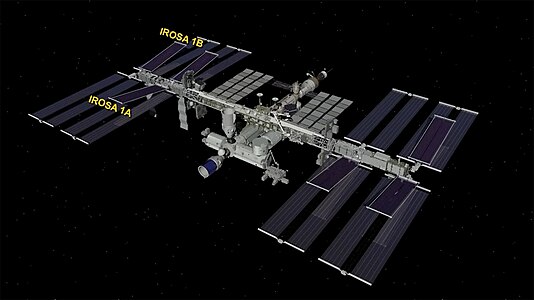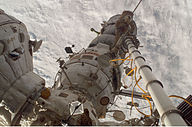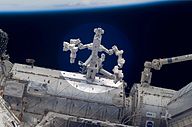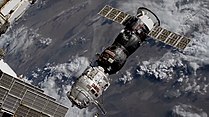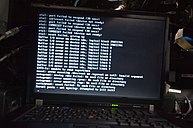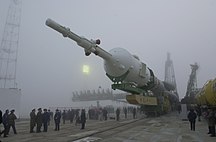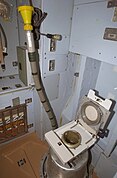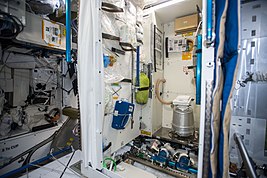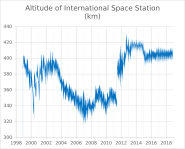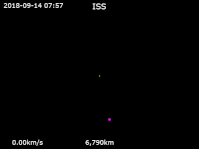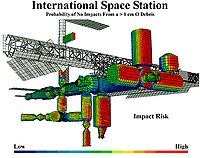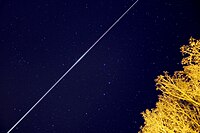International Space Station
 Oblique underside view in November 2021 | |
 International Space Station programme emblem with flags of the original signatory states | |
| Station statistics | |
|---|---|
| COSPAR ID | 1998-067A |
| SATCAT no. | 25544 |
| Call sign | Alpha, Station |
| Crew |
|
| Launch | 20 November 1998 |
| Launch pad | |
| Mass | 450,000 kg (990,000 lb)[1] |
| Length | 109 m (358 ft) (overall), 94 m (310 ft) (truss)[2] |
| Width | 73 m (239 ft) (solar array)[2] |
| Pressurised volume | 1,005.0 m3 (35,491 cu ft)[2] |
| Atmospheric pressure | 1 atm (101.3 kPa; 14.7 psi) 79% nitrogen, 21% oxygen |
| Perigee altitude | 413 km (256.6 mi) AMSL[3] |
| Apogee altitude | 422 km (262.2 mi) AMSL[3] |
| Orbital inclination | 51.64°[3] |
| Orbital speed | 7.67 km/s; 27,600 km/h; 17,100 mph[4] |
| Orbital period | 92.9 minutes[5] |
| Orbits per day | 15.5[3] |
| Orbit epoch | 16 August 16:19:30[6] |
| Days in orbit | 25 years, 11 months, 14 days as of 3 November 2024 |
| Days occupied | 24 years, 1 day as of 3 November 2024 |
| No. of orbits | 141,117 as of August 2023[update][6] |
| Orbital decay | 2 km/month (1.2 mi/month) |
| Statistics as of 22 December 2022 (unless noted otherwise) References:[2][3][7][8][9] | |
| Configuration | |
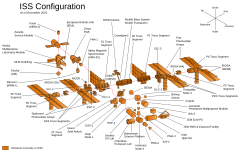 | |
The International Space Station (ISS) is a large space station that was assembled and is maintained in low Earth orbit by a collaboration of five space agencies and their contractors: NASA (United States), Roscosmos (Russia), ESA (Europe), JAXA (Japan), and CSA (Canada). The ISS is the largest space station ever built. Its primary purpose is to perform microgravity and space environment experiments.[10]
Operationally, the station is divided into two sections: the Russian Orbital Segment (ROS) assembled by Roscosmos, and the US Orbital Segment (USOS), assembled by NASA, JAXA, ESA and CSA. A striking feature of the ISS is the Integrated Truss Structure, which connects the large solar panels and radiators to the pressurized modules. The pressurized modules are specialized for research, habitation, storage, spacecraft control, and airlock functions. Visiting spacecraft dock at the station via its eight docking and berthing ports. The ISS maintains an orbit with an average altitude of 400 kilometres (250 mi)[11] and circles the Earth in roughly 93 minutes, completing 15.5 orbits per day.[12]
The ISS programme combines two prior plans to construct crewed Earth-orbiting stations: Space Station Freedom planned by the United States, and the Mir-2 station, planned by the Soviet Union. The first ISS module was launched in 1998. Major modules have been launched by Proton and Soyuz rockets and by the Space Shuttle launch system. The first long-term residents, Expedition 1, arrived on 2 November 2000. Since then, the station has been continuously occupied for 24 years and 1 day, the longest continuous human presence in space. As of March 2024[update], 279 individuals from 22 countries have visited the space station.[13] The ISS is expected to have additional modules (the Axiom Orbital Segment, for example) and will be in service until the end of 2030, after which it is planned to be de-orbited by a dedicated NASA spacecraft.[14]
Conception
[edit]As the space race drew to a close in the early 1970s, the US and USSR began to contemplate a variety of potential collaborations in outer space. This culminated in the 1975 Apollo-Soyuz Test Project, the first docking of spacecraft from two different spacefaring nations. The ASTP was considered a success, and further joint missions were also contemplated.
One such concept was International Skylab, which proposed launching the backup Skylab B space station for a mission that would see multiple visits by both Apollo and Soyuz crew vehicles.[15] More ambitious was the Skylab-Salyut Space Laboratory, which proposed docking the Skylab B to a Soviet Salyut space station. Falling budgets and rising Cold War tensions in the late 1970s saw these concepts fall by the wayside, along with another plan to have the Space Shuttle dock with a Salyut space station.[16]
In the early 1980s, NASA planned to launch a modular space station called Freedom as a counterpart to the Salyut and Mir space stations. In 1984 the ESA was invited to participate in Space Station Freedom, and the ESA approved the Columbus laboratory by 1987.[17] The Japanese Experiment Module (JEM), or Kibō, was announced in 1985, as part of the Freedom space station in response to a NASA request in 1982.
In early 1985, science ministers from the European Space Agency (ESA) countries approved the Columbus programme, the most ambitious effort in space undertaken by that organization at the time. The plan spearheaded by Germany and Italy included a module which would be attached to Freedom, and with the capability to evolve into a full-fledged European orbital outpost before the end of the century.[18]
Increasing costs threw these plans into doubt in the early 1990s. Congress was unwilling to provide enough money to build and operate Freedom, and demanded NASA increase international participation to defray the rising costs or they would cancel the entire project outright.[19]
Simultaneously, the USSR was conducting planning for the Mir-2 space station, and had begun constructing modules for the new station by the mid-1980s. However the collapse of the Soviet Union required these plans to be greatly downscaled, and soon Mir-2 was in danger of never being launched at all.[20] With both space station projects in jeopardy, American and Russian officials met and proposed they be combined. [21]
In September 1993, American Vice-President Al Gore and Russian Prime Minister Viktor Chernomyrdin announced plans for a new space station, which eventually became the International Space Station.[22] They also agreed, in preparation for this new project, that the United States would be involved in the Mir programme, including American Shuttles docking, in the Shuttle–Mir programme.[23]Purpose
[edit]The ISS was originally intended to be a laboratory, observatory, and factory while providing transportation, maintenance, and a low Earth orbit staging base for possible future missions to the Moon, Mars, and asteroids. However, not all of the uses envisioned in the initial memorandum of understanding between NASA and Roscosmos have been realised.[24] In the 2010 United States National Space Policy, the ISS was given additional roles of serving commercial, diplomatic,[25] and educational purposes.[26]
Scientific research
[edit]The ISS provides a platform to conduct scientific research, with power, data, cooling, and crew available to support experiments. Small uncrewed spacecraft can also provide platforms for experiments, especially those involving zero gravity and exposure to space, but space stations offer a long-term environment where studies can be performed potentially for decades, combined with ready access by human researchers.[27][28]
The ISS simplifies individual experiments by allowing groups of experiments to share the same launches and crew time. Research is conducted in a wide variety of fields, including astrobiology, astronomy, physical sciences, materials science, space weather, meteorology, and human research including space medicine and the life sciences.[29][30][31][32] Scientists on Earth have timely access to the data and can suggest experimental modifications to the crew. If follow-on experiments are necessary, the routinely scheduled launches of resupply craft allows new hardware to be launched with relative ease.[28] Crews fly expeditions of several months' duration, providing approximately 160 person-hours per week of labour with a crew of six. However, a considerable amount of crew time is taken up by station maintenance.[33]
Perhaps the most notable ISS experiment is the Alpha Magnetic Spectrometer (AMS), which is intended to detect dark matter and answer other fundamental questions about our universe. According to NASA, the AMS is as important as the Hubble Space Telescope. Currently docked on station, it could not have been easily accommodated on a free flying satellite platform because of its power and bandwidth needs.[34][35] On 3 April 2013, scientists reported that hints of dark matter may have been detected by the AMS.[36][37][38][39][40][41] According to the scientists, "The first results from the space-borne Alpha Magnetic Spectrometer confirm an unexplained excess of high-energy positrons in Earth-bound cosmic rays".[citation needed]
The space environment is hostile to life. Unprotected presence in space is characterised by an intense radiation field (consisting primarily of protons and other subatomic charged particles from the solar wind, in addition to cosmic rays), high vacuum, extreme temperatures, and microgravity.[42] Some simple forms of life called extremophiles,[43] as well as small invertebrates called tardigrades[44] can survive in this environment in an extremely dry state through desiccation.
Medical research improves knowledge about the effects of long-term space exposure on the human body, including muscle atrophy, bone loss, and fluid shift. These data will be used to determine whether high duration human spaceflight and space colonisation are feasible. In 2006, data on bone loss and muscular atrophy suggested that there would be a significant risk of fractures and movement problems if astronauts landed on a planet after a lengthy interplanetary cruise, such as the six-month interval required to travel to Mars.[45][46]
Medical studies are conducted aboard the ISS on behalf of the National Space Biomedical Research Institute (NSBRI). Prominent among these is the Advanced Diagnostic Ultrasound in Microgravity study in which astronauts perform ultrasound scans under the guidance of remote experts. The study considers the diagnosis and treatment of medical conditions in space. Usually, there is no physician on board the ISS and diagnosis of medical conditions is a challenge. It is anticipated that remotely guided ultrasound scans will have application on Earth in emergency and rural care situations where access to a trained physician is difficult.[47][48][49]
In August 2020, scientists reported that bacteria from Earth, particularly Deinococcus radiodurans bacteria, which is highly resistant to environmental hazards, were found to survive for three years in outer space, based on studies conducted on the International Space Station. These findings supported the notion of panspermia, the hypothesis that life exists throughout the Universe, distributed in various ways, including space dust, meteoroids, asteroids, comets, planetoids or contaminated spacecraft.[50][51]
Remote sensing of the Earth, astronomy, and deep space research on the ISS have significantly increased during the 2010s after the completion of the US Orbital Segment in 2011. Throughout the more than 20 years of the ISS program, researchers aboard the ISS and on the ground have examined aerosols, ozone, lightning, and oxides in Earth's atmosphere, as well as the Sun, cosmic rays, cosmic dust, antimatter, and dark matter in the universe. Examples of Earth-viewing remote sensing experiments that have flown on the ISS are the Orbiting Carbon Observatory 3, ISS-RapidScat, ECOSTRESS, the Global Ecosystem Dynamics Investigation, and the Cloud Aerosol Transport System. ISS-based astronomy telescopes and experiments include SOLAR, the Neutron Star Interior Composition Explorer, the Calorimetric Electron Telescope, the Monitor of All-sky X-ray Image (MAXI), and the Alpha Magnetic Spectrometer.[29][52]
Freefall
[edit]

Gravity at the altitude of the ISS is approximately 90% as strong as at Earth's surface, but objects in orbit are in a continuous state of freefall, resulting in an apparent state of weightlessness.[53] This perceived weightlessness is disturbed by five effects:[54]
- Drag from the residual atmosphere.
- Vibration from the movements of mechanical systems and the crew.
- Actuation of the on-board attitude control moment gyroscopes.
- Thruster firings for attitude or orbital changes.
- Gravity-gradient effects, also known as tidal effects. Items at different locations within the ISS would, if not attached to the station, follow slightly different orbits. Being mechanically connected, these items experience small forces that keep the station moving as a rigid body.
Researchers are investigating the effect of the station's near-weightless environment on the evolution, development, growth and internal processes of plants and animals. In response to some of the data, NASA wants to investigate microgravity's effects on the growth of three-dimensional, human-like tissues and the unusual protein crystals that can be formed in space.[29]
Investigating the physics of fluids in microgravity will provide better models of the behaviour of fluids. Because fluids can be almost completely combined in microgravity, physicists investigate fluids that do not mix well on Earth. Examining reactions that are slowed by low gravity and low temperatures will improve our understanding of superconductivity.[29]
The study of materials science is an important ISS research activity, with the objective of reaping economic benefits through the improvement of techniques used on Earth.[55] Other areas of interest include the effect of low gravity on combustion, through the study of the efficiency of burning and control of emissions and pollutants. These findings may improve knowledge about energy production and lead to economic and environmental benefits.[29]
Exploration
[edit]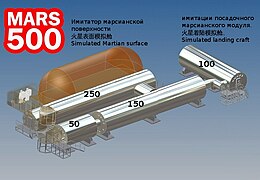
The ISS provides a location in the relative safety of low Earth orbit to test spacecraft systems that will be required for long-duration missions to the Moon and Mars. This provides experience in operations, maintenance, and repair and replacement activities on-orbit. This will help develop essential skills in operating spacecraft farther from Earth, reduce mission risks, and advance the capabilities of interplanetary spacecraft.[56] Referring to the MARS-500 experiment, a crew isolation experiment conducted on Earth, ESA states, "Whereas the ISS is essential for answering questions concerning the possible impact of weightlessness, radiation and other space-specific factors, aspects such as the effect of long-term isolation and confinement can be more appropriately addressed via ground-based simulations".[57] Sergey Krasnov, the head of human space flight programmes for Russia's space agency, Roscosmos, in 2011 suggested a "shorter version" of MARS-500 may be carried out on the ISS.[58]
In 2009, noting the value of the partnership framework itself, Sergey Krasnov wrote, "When compared with partners acting separately, partners developing complementary abilities and resources could give us much more assurance of the success and safety of space exploration. The ISS is helping further advance near-Earth space exploration and realisation of prospective programmes of research and exploration of the Solar system, including the Moon and Mars."[59] A crewed mission to Mars may be a multinational effort involving space agencies and countries outside the current ISS partnership. In 2010, ESA Director-General Jean-Jacques Dordain stated his agency was ready to propose to the other four partners that China, India, and South Korea be invited to join the ISS partnership.[60] NASA chief Charles Bolden stated in February 2011, "Any mission to Mars is likely to be a global effort."[61] Currently, US federal legislation prevents NASA co-operation with China on space projects without approval by the FBI and Congress.[62]
Education and cultural outreach
[edit]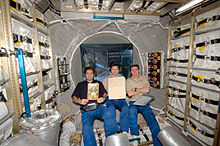
The ISS crew provides opportunities for students on Earth by running student-developed experiments, making educational demonstrations, allowing for student participation in classroom versions of ISS experiments, and directly engaging students using radio, and email.[63][64] ESA offers a wide range of free teaching materials that can be downloaded for use in classrooms.[65] In one lesson, students can navigate a 3D model of the interior and exterior of the ISS, and face spontaneous challenges to solve in real time.[66]
The Japanese Aerospace Exploration Agency (JAXA) aims to inspire children to "pursue craftsmanship" and to heighten their "awareness of the importance of life and their responsibilities in society".[67] Through a series of education guides, students develop a deeper understanding of the past and near-term future of crewed space flight, as well as that of Earth and life.[68][69] In the JAXA "Seeds in Space" experiments, the mutation effects of spaceflight on plant seeds aboard the ISS are explored by growing sunflower seeds that have flown on the ISS for about nine months. In the first phase of Kibō utilisation from 2008 to mid-2010, researchers from more than a dozen Japanese universities conducted experiments in diverse fields.[70]
Cultural activities are another major objective of the ISS programme. Tetsuo Tanaka, the director of JAXA's Space Environment and Utilization Center, has said: "There is something about space that touches even people who are not interested in science."[71]
Amateur Radio on the ISS (ARISS) is a volunteer programme that encourages students worldwide to pursue careers in science, technology, engineering, and mathematics, through amateur radio communications opportunities with the ISS crew. ARISS is an international working group, consisting of delegations from nine countries including several in Europe, as well as Japan, Russia, Canada, and the United States. In areas where radio equipment cannot be used, speakerphones connect students to ground stations which then connect the calls to the space station.[72]
First Orbit is a 2011 feature-length documentary film about Vostok 1, the first crewed space flight around the Earth. By matching the orbit of the ISS to that of Vostok 1 as closely as possible, in terms of ground path and time of day, documentary filmmaker Christopher Riley and ESA astronaut Paolo Nespoli were able to film the view that Yuri Gagarin saw on his pioneering orbital space flight. This new footage was cut together with the original Vostok 1 mission audio recordings sourced from the Russian State Archive. Nespoli is credited as the director of photography for this documentary film, as he recorded the majority of the footage himself during Expedition 26/27.[73] The film was streamed in a global YouTube premiere in 2011 under a free licence through the website firstorbit.org.[74]
In May 2013, commander Chris Hadfield shot a music video of David Bowie's "Space Oddity" on board the station, which was released on YouTube.[75][76] It was the first music video filmed in space.[77]
In November 2017, while participating in Expedition 52/53 on the ISS, Paolo Nespoli made two recordings of his spoken voice (one in English and the other in his native Italian), for use on Wikipedia articles. These were the first content made in space specifically for Wikipedia.[78][79]
In November 2021, a virtual reality exhibit called The Infinite featuring life aboard the ISS was announced.[80]
Construction
[edit]Manufacturing
[edit]
The International Space Station is a product of global collaboration, with its components manufactured across the world.
The modules of the Russian Orbital Segment, including Zarya and Zvezda, were produced at the Khrunichev State Research and Production Space Center in Moscow. Zvezda was initially manufactured in 1985 as a component for the Mir-2 space station, which was never launched.[81][82]
Much of the US Orbital Segment, including the Destiny and Unity modules, the Integrated Truss Structure, and solar arrays, were built at NASA's Marshall Space Flight Center in Huntsville, Alabama and Michoud Assembly Facility in New Orleans.[81] These components underwent final assembly and processing for launch at the Operations and Checkout Building and the Space Station Processing Facility (SSPF) at the Kennedy Space Center in Florida.[83]
The US Orbital Segment also hosts the Columbus module contributed by the European Space Agency and built in Germany, the Kibō module contributed by Japan and built at the Tsukuba Space Center and the Institute of Space and Astronautical Science, along with the Canadarm2 and Dextre, a joint Canadian-U.S. endeavor. All of these components were shipped to the SSPF for launch processing.[81][84]
Assembly
[edit]
The assembly of the International Space Station, a major endeavour in space architecture, began in November 1998.[7]
Modules in the Russian segment launched and docked autonomously, with the exception of Rassvet. Other modules and components were delivered by the Space Shuttle, which then had to be installed by astronauts either remotely using robotic arms or during spacewalks, more formally known as extra-vehicular activities (EVAs). By 5 June 2011 astronauts had made over 159 EVAs to add components to the station, totaling more than 1,000 hours in space.[85][86]

The foundation for the ISS was laid with the launch of the Russian-built Zarya module atop a Proton rocket on 20 November 1998. Zarya provided propulsion, attitude control, communications, and electrical power. Two weeks later on 4 December 1998, the American-made Unity was ferried aboard Space Shuttle Endeavour on STS-88 and joined with Zarya. Unity provided the connection between the Russian and US segments of the station and would provide ports to connect future modules and visiting spacecraft.
While the connection of two modules built on different continents, by nations that were once bitter rivals was a significant milestone, these two initial modules lacked life support systems and the ISS remained unmanned for the next two years. At the time, the Russian station Mir was still inhabited.
The turning point arrived in July 2000 with the launch of the Zvezda module. Equipped with living quarters and life-support systems, Zvezda enabled continuous human presence aboard the station. The first crew, Expedition 1, arrived that November aboard Soyuz TM-31.[87][88]
The ISS grew steadily over the following years, with modules delivered by both Russian rockets and the Space Shuttle.
Expedition 1 arrived midway between the Space Shuttle flights of missions STS-92 and STS-97. These two flights each added segments of the station's Integrated Truss Structure, which provided the station with Ku band communications, additional attitude control needed for the additional mass of the USOS, and additional solar arrays.[89] Over the next two years, the station continued to expand. A Soyuz-U rocket delivered the Pirs docking compartment. The Space Shuttles Discovery, Atlantis, and Endeavour delivered the American Destiny laboratory and Quest airlock, in addition to the station's main robot arm, the Canadarm2, and several more segments of the Integrated Truss Structure.
Tragedy struck in 2003 with the loss of the Space Shuttle Columbia, which grounded the rest of the Shuttle fleet, halting construction of the ISS.

Assembly resumed in 2006 with the arrival of STS-115 with Atlantis, which delivered the station's second set of solar arrays. Several more truss segments and a third set of arrays were delivered on STS-116, STS-117, and STS-118. As a result of the major expansion of the station's power-generating capabilities, more modules could be accommodated, and the US Harmony module and Columbus European laboratory were added. These were soon followed by the first two components of the Japanese Kibō laboratory. In March 2009, STS-119 completed the Integrated Truss Structure with the installation of the fourth and final set of solar arrays. The final section of Kibō was delivered in July 2009 on STS-127, followed by the Russian Poisk module. The US Tranquility module was delivered in February 2010 during STS-130, alongside the Cupola, followed by the penultimate Russian module, Rassvet, in May 2010. Rassvet was delivered by Space Shuttle Atlantis on STS-132 in exchange for the Russian Proton delivery of the US-funded Zarya module in 1998.[90] The last pressurised module of the USOS, Leonardo, was brought to the station in February 2011 on the final flight of Discovery, STS-133.[91]
Russia's new primary research module Nauka docked in July 2021,[92] along with the European Robotic Arm which can relocate itself to different parts of the Russian modules of the station.[93] Russia's latest addition, the Prichal module, docked in November 2021.[94]
As of November 2021, the station consists of 18 pressurised modules (including airlocks) and the Integrated Truss Structure.
Structure
[edit]The ISS functions as a modular space station, enabling the addition or removal of modules from its structure for increased adaptability.
- Blueprint of ISS (as of 2018)
- Rendering of ISS (as of 2023)
Below is a diagram of major station components. The Unity node joins directly to the Destiny laboratory; for clarity, they are shown apart. Similar cases are also seen in other parts of the structure.
Key to box background colors:
- Pressurised component, accessible by the crew without using spacesuits
- Docking/berthing port, pressurized when a visiting spacecraft is present
- Airlock, to move people or material between pressurized and unpressurized environment
- Unpressurised station superstructure
- Unpressurised component
- Temporarily defunct or non-commissioned component
- Former, no longer installed component
- Future, not yet installed component
Pressurised modules
[edit]Zarya
[edit]
Zarya (Russian: Заря, lit. 'Dawn'[c]), also known as the Functional Cargo Block (Russian: Функционально-грузовой блок), was the inaugural component of the ISS. Launched in 1998, it initially served as the ISS's power source, storage, propulsion, and guidance system. As the station has grown, Zarya's role has transitioned primarily to storage, both internally and in its external fuel tanks.[95]
A descendant of the TKS spacecraft used in the Salyut programme, Zarya was built in Russia but is owned by the United States. Its name, meaning "dawn," symbolizes the beginning of a new era of international space cooperation.[96]
Unity
[edit]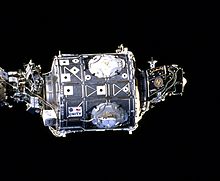
Unity, also known as Node 1, is the inaugural U.S.-built component of the ISS.[97][98] Serving as the connection between the Russian and U.S. segments, this cylindrical module features six Common Berthing Mechanism locations (forward, aft, port, starboard, zenith, and nadir) for attaching additional modules. Measuring 4.57 metres (15.0 ft) in diameter and 5.47 metres (17.9 ft) in length, Unity was constructed of steel by Boeing for NASA at the Marshall Space Flight Center in Huntsville, Alabama. It was the first of three connecting nodes – Unity, Harmony, and Tranquility – that forms the structural backbone of the U.S. segment of the ISS.[99]
Zvezda
[edit]
Zvezda (Russian: Звезда, lit. 'star') launched in July 2000, is the core of the Russian Orbital Segment of the ISS. Initially providing essential living quarters and life support systems, it enabled the first continuous human presence aboard the station. While additional modules have expanded the ISS's capabilities, Zvezda remains the command and control center for the Russian segment and it is where crews gather during emergencies.[100][101][102]
A descendant of the Salyut programme's DOS spacecraft, Zvezda was built by RKK Energia and launched atop a Proton rocket.[103]
Destiny
[edit]
The Destiny laboratory is the primary research facility for U.S. experiments on the ISS. NASA's first permanent orbital research station since Skylab, the module was built by Boeing and launched aboard Space Shuttle Atlantis during STS-98. Attached to Unity over a period of five days in February 2001, Destiny has been a hub for scientific research ever since.[104][105][106]
Within Destiny, astronauts conduct experiments in fields such as medicine, engineering, biotechnology, physics, materials science, and Earth science. Researchers worldwide benefit from these studies. The module also houses life support systems, including the Oxygen Generating System.[107]
Quest Joint Airlock
[edit]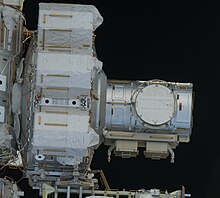
The Quest Joint Airlock enables extravehicular activities (EVAs) using either the U.S. Extravehicular Mobility Unit (EMU) or the Russian Orlan space suit.[108]
Before its installation, conducting EVAs from the ISS was challenging due to a variety of system and design differences. Only the Orlan suit could be used from the Transfer Chamber on the Zvezda module (which was not a purpose-built airlock) and the EMU could only be used from the airlock on a visiting Space Shuttle, which could not accommodate the Orlan.[109]
Launched aboard Space Shuttle Atlantis during STS-104 in July 2001 and attached to the Unity module, Quest is a 6.1-metre-long (20 ft), 4.0-metre-wide (13 ft) structure built by Boeing.[110] It houses the crew airlock for astronaut egress, an equipment airlock for suit storage, and has facilities to accommodate astronauts during their overnight pre-breathe procedures to prevent decompression sickness.[109]
The crew airlock, derived from the Space Shuttle, features essential equipment like lighting, handrails, and an Umbilical Interface Assembly (UIA) that provides life support and communication systems for up to two spacesuits simultaneously. These can be either two EMUs, two Orlan suits, or one of each design.
Poisk
[edit]Poisk (Russian: По́иск, lit. 'Search'), also known as the Mini-Research Module 2 (Russian: Малый исследовательский модуль 2), serves as both a secondary airlock on the Russian segment of the ISS and supports docking for Soyuz and Progress spacecraft, facilitates propellant transfers from the latter.[111] Launched on 10 November 2009 attached to a modified Progress spacecraft, called Progress M-MIM2.[112][113]
Poisk provides facilities to maintain Orlan spacesuits and is equipped with two inward-opening hatches, a design change from Mir, which encountered a dangerous situation caused by an outward-opening hatch that opened too quickly because of a small amount of air pressure remaining in the airlock.[114] Since the departure of Pirs in 2021, it's become the sole airlock on the Russian segment.
Harmony
[edit]
Harmony, or Node 2, is the central connecting hub of the US segment of the ISS, linking the U.S., European, and Japanese laboratory modules. It's also been called the "utility hub" of the ISS as it provides essential power, data, and life support systems. The module also houses sleeping quarters for four crew members.[115]
Launched on 23 October 2007 aboard Space Shuttle Discovery on STS-120,[116][117] Harmony was initially attached to the Unity[118][119] before being relocated to its permanent position at the front of the Destiny laboratory on 14 November 2007.[120] This expansion added significant living space to the ISS, marking a key milestone in the construction of the U.S. segment.
Tranquility
[edit]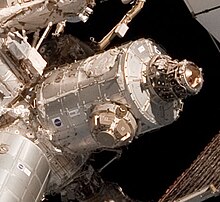
Tranquility, also known as Node 3, is a module of the ISS. It contains environmental control systems, life support systems, a toilet, exercise equipment, and an observation cupola.
The European Space Agency and the Italian Space Agency had Tranquility manufactured by Thales Alenia Space. A ceremony on 20 November 2009 transferred ownership of the module to NASA.[121] On 8 February 2010, NASA launched the module on the Space Shuttle's STS-130 mission.
Columbus
[edit]
Columbus is a science laboratory that is part of the ISS and is the largest single contribution to the station made by the European Space Agency.
Like the Harmony and Tranquility modules, the Columbus laboratory was constructed in Turin, Italy by Thales Alenia Space. The functional equipment and software of the lab was designed by EADS in Bremen, Germany. It was also integrated in Bremen before being flown to the Kennedy Space Center in Florida in an Airbus Beluga jet. It was launched aboard Space Shuttle Atlantis on 7 February 2008, on flight STS-122. It is designed for ten years of operation. The module is controlled by the Columbus Control Centre, located at the German Space Operations Center, part of the German Aerospace Center in Oberpfaffenhofen near Munich, Germany.
The European Space Agency has spent €1.4 billion (about US$1.6 billion) on building Columbus, including the experiments it carries and the ground control infrastructure necessary to operate them.[122]
Kibō
[edit]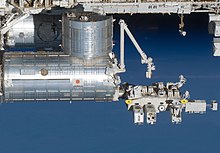
Kibō (Japanese: きぼう, lit. 'hope'), also known as the Japanese Experiment Module, is Japan's research facility on the ISS. It is the largest single module on the ISS, consisting of a pressurized lab, an exposed facility for conducting experiments in the space environment, two storage compartments, and a robotic arm. Attached to the Harmony module, Kibō was assembled in space over three Space Shuttle missions: STS-123, STS-124 and STS-127.[123]
Cupola
[edit]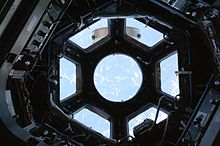
The Cupola is an ESA-built observatory module of the ISS. Its name derives from the Italian word cupola, which means "dome". Its seven windows are used to conduct experiments, dockings and observations of Earth. It was launched aboard Space Shuttle mission STS-130 on 8 February 2010 and attached to the Tranquility (Node 3) module. With the Cupola attached, ISS assembly reached 85 per cent completion. The Cupola's central window has a diameter of 80 cm (31 in).[124]
Rassvet
[edit]
Rassvet (Russian: Рассвет, lit. 'first light'), also known as the Mini-Research Module 1 (Russian: Малый исследовательский модуль 1) and formerly known as the Docking Cargo Module is primarily used for cargo storage and as a docking port for visiting spacecraft on the Russian segment of the ISS. Rassvet replaced the cancelled Docking and Storage Module and used a design largely based on the Mir Docking Module built in 1995.
Rassvet was delivered in on 14 May 2010 Space Shuttle Atlantis on STS-132 in exchange for the Russian Proton delivery of the US-funded Zarya module in 1998.[125] Rassvet was attached to Zarya shortly thereafter.[126]
Science (or Experiment) Airlock
[edit]
The airlock, ShK, is designed for a payload with dimensions up to 1,200 mm × 500 mm × 500 mm (47 in × 20 in × 20 in), has a volume of 2.1 m3, weight of 1050 kg and consumes 1.5 kW of power at the peak. Prior to berthing the MLM to the ISS, the airlock is stowed as part of MRM1.[127] On 4 May 2023, 01:00 UTC, the chamber was moved by the ERA manipulator and berthed to the forward active docking port of the pressurized docking hub of the Nauka module during VKD-57 spacewalk. It is intended to be used:
- for extracting payloads and from the MLM docking adapter and placing them on the outer surface of the station;
- enable science investigations to be removed, exposed to the external microgravity environment, then returned inside while being maneuvered with the European robotic arm.
- for receiving payloads from the ERA manipulator and moving them into the internal volume of the airlock and further into the MLM pressurized adapter;
- for conducting scientific experiments in the internal volume of the airlock;
- for conducting scientific experiments outside the airlock chamber on an extended table and in a special organized place.[127][128]
- for launching cubesats into space, with the aid of ERA – very similar to the Japanese airlock and Nanoracks Bishop Airlock on the U.S. segment of the station.[129]
Leonardo
[edit]The Leonardo Permanent Multipurpose Module (PMM) is a module of the International Space Station. It was flown into space aboard the Space Shuttle on STS-133 on 24 February 2011 and installed on 1 March. Leonardo is primarily used for storage of spares, supplies and waste on the ISS, which was until then stored in many different places within the space station. It is also the personal hygiene area for the astronauts who live in the US Orbital Segment. The Leonardo PMM was a Multi-Purpose Logistics Module (MPLM) before 2011, but was modified into its current configuration. It was formerly one of two MPLM used for bringing cargo to and from the ISS with the Space Shuttle. The module was named for Italian polymath Leonardo da Vinci.
Bigelow Expandable Activity Module
[edit]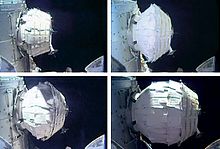
The Bigelow Expandable Activity Module (BEAM) is an experimental expandable space station module developed by Bigelow Aerospace, under contract to NASA, for testing as a temporary module on the International Space Station (ISS) from 2016 to at least 2020. It arrived at the ISS on 10 April 2016,[130] was berthed to the station on 16 April at Tranquility Node 3, and was expanded and pressurized on 28 May 2016. In December 2021, Bigelow Aerospace conveyed ownership of the module to NASA, as a result of Bigelow's cessation of activity.[131]
International Docking Adapters
[edit]The International Docking Adapter (IDA) is a spacecraft docking system adapter developed to convert APAS-95 to the NASA Docking System (NDS). An IDA is placed on each of the ISS's two open Pressurized Mating Adapters (PMAs), both of which are connected to the Harmony module.
Two International Docking Adapters are currently installed aboard the Station. Originally, IDA-1 was planned to be installed on PMA-2, located at Harmony's forward port, and IDA-2 would be installed on PMA-3 at Harmony's zenith. After IDA 1 was destroyed in a launch incident, IDA-2 was installed on PMA-2 on 19 August 2016,[132] while IDA-3 was later installed on PMA-3 on 21 August 2019.[133]
Bishop Airlock Module
[edit]
The NanoRacks Bishop Airlock Module is a commercially funded airlock module launched to the ISS on SpaceX CRS-21 on 6 December 2020.[134][135] The module was built by NanoRacks, Thales Alenia Space, and Boeing.[136] It will be used to deploy CubeSats, small satellites, and other external payloads for NASA, CASIS, and other commercial and governmental customers.[137]
Nauka
[edit]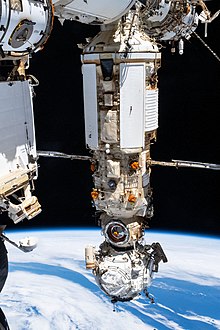
Nauka (Russian: Наука, lit. 'Science'), also known as the Multipurpose Laboratory Module, Upgrade (Russian: Многоцелевой лабораторный модуль, усоверше́нствованный), is a Roscosmos-funded component of the ISS that was launched on 21 July 2021, 14:58 UTC. In the original ISS plans, Nauka was to use the location of the Docking and Stowage Module (DSM), but the DSM was later replaced by the Rassvet module and moved to Zarya's nadir port. Nauka was successfully docked to Zvezda's nadir port on 29 July 2021, 13:29 UTC, replacing the Pirs module.
It had a temporary docking adapter on its nadir port for crewed and uncrewed missions until Prichal arrival, where just before its arrival it was removed by a departing Progress spacecraft.[138]
Prichal
[edit]Prichal (Russian: Причал, lit. 'pier') is a 4-tonne (8,800 lb) spherical module that serves as a docking hub for the Russian segment of the ISS. Launched in November 2021, Prichal provides additional docking ports for Soyuz and Progress spacecraft, as well as potential future modules. Prichal features six docking ports: forward, aft, port, starboard, zenith, and nadir. One of these ports, equipped with an active hybrid docking system, enabled it to dock with the Nauka module. The remaining five ports are passive hybrids, allowing for docking of Soyuz, Progress, and heavier modules, as well as future spacecraft with modified docking systems. As of 2024, the forward, aft, port and starboard docking ports remain covered. Prichal was initially intended to be an element of the now canceled Orbital Piloted Assembly and Experiment Complex.[139][140][141][142]
Unpressurised elements
[edit]The ISS has a large number of external components that do not require pressurisation. The largest of these is the Integrated Truss Structure (ITS), to which the station's main solar arrays and thermal radiators are mounted.[143] The ITS consists of ten separate segments forming a structure 108.5 metres (356 ft) long.[7]
The station was intended to have several smaller external components, such as six robotic arms, three External Stowage Platforms (ESPs) and four ExPRESS Logistics Carriers (ELCs).[144][145] While these platforms allow experiments (including MISSE, the STP-H3 and the Robotic Refueling Mission) to be deployed and conducted in the vacuum of space by providing electricity and processing experimental data locally, their primary function is to store spare Orbital Replacement Units (ORUs). ORUs are parts that can be replaced when they fail or pass their design life, including pumps, storage tanks, antennas, and battery units. Such units are replaced either by astronauts during EVA or by robotic arms.[146] Several shuttle missions were dedicated to the delivery of ORUs, including STS-129,[147] STS-133[148] and STS-134.[149] As of January 2011[update], only one other mode of transportation of ORUs had been used – the Japanese cargo vessel HTV-2 – which delivered an FHRC and CTC-2 via its Exposed Pallet (EP).[150][needs update]
There are also smaller exposure facilities mounted directly to laboratory modules; the Kibō Exposed Facility serves as an external "porch" for the Kibō complex,[151] and a facility on the European Columbus laboratory provides power and data connections for experiments such as the European Technology Exposure Facility[152][153] and the Atomic Clock Ensemble in Space.[154] A remote sensing instrument, SAGE III-ISS, was delivered to the station in February 2017 aboard CRS-10,[155] and the NICER experiment was delivered aboard CRS-11 in June 2017.[156] The largest scientific payload externally mounted to the ISS is the Alpha Magnetic Spectrometer (AMS), a particle physics experiment launched on STS-134 in May 2011, and mounted externally on the ITS. The AMS measures cosmic rays to look for evidence of dark matter and antimatter.[157][158]
The commercial Bartolomeo External Payload Hosting Platform, manufactured by Airbus, was launched on 6 March 2020 aboard CRS-20 and attached to the European Columbus module. It will provide an additional 12 external payload slots, supplementing the eight on the ExPRESS Logistics Carriers, ten on Kibō, and four on Columbus. The system is designed to be robotically serviced and will require no astronaut intervention. It is named after Christopher Columbus's younger brother.[159][160][161]
MLM outfittings
[edit]In May 2010, equipment for Nauka was launched on STS-132 (as part of an agreement with NASA) and delivered by Space Shuttle Atlantis. Weighing 1.4 metric tons, the equipment was attached to the outside of Rassvet (MRM-1). It included a spare elbow joint for the European Robotic Arm (ERA) (which was launched with Nauka) and an ERA-portable workpost used during EVAs, as well as RTOd add-on heat radiator and internal hardware alongside the pressurized experiment airlock.[129]
The RTOd radiator adds additional cooling capability to Nauka, which enables the module to host more scientific experiments.[129]
The ERA was used to remove the RTOd radiator from Rassvet and transferred over to Nauka during VKD-56 spacewalk. Later it was activated and fully deployed on VKD-58 spacewalk.[162] This process took several months. A portable work platform was also transferred over in August 2023 during VKD-60 spacewalk, which can attach to the end of the ERA to allow cosmonauts to "ride" on the end of the arm during spacewalks.[163][164] However, even after several months of outfitting EVAs and RTOd heat radiator installation, six months later, the RTOd radiator malfunctioned before active use of Nauka (the purpose of RTOd installation is to radiate heat from Nauka experiments). The malfunction, a leak, rendered the RTOd radiator unusable for Nauka. This is the third ISS radiator leak after Soyuz MS-22 and Progress MS-21 radiator leaks. If a spare RTOd is not available, Nauka experiments will have to rely on Nauka's main launch radiator and the module could never be used to its full capacity.[165][166]
Another MLM outfitting is a 4 segment external payload interface called means of attachment of large payloads (Sredstva Krepleniya Krupnogabaritnykh Obyektov, SKKO).[167] Delivered in two parts to Nauka by Progress MS-18 (LCCS part) and Progress MS-21 (SCCCS part) as part of the module activation outfitting process.[168][169][170][171] It was taken outside and installed on the ERA aft facing base point on Nauka during the VKD-55 spacewalk.[172][173][174][175]
Robotic arms and cargo cranes
[edit]Strela crane (which is holding photographer Oleg Kononenko).
The Integrated Truss Structure (ITS) serves as a base for the station's primary remote manipulator system, the Mobile Servicing System (MSS), which is composed of three main components:
- Canadarm2, the largest robotic arm on the ISS, has a mass of 1,800 kilograms (4,000 lb) and is used to: dock and manipulate spacecraft and modules on the USOS; hold crew members and equipment in place during EVAs; and move Dextre to perform tasks.[176]
- Dextre is a 1,560 kg (3,440 lb) robotic manipulator that has two arms and a rotating torso, with power tools, lights, and video for replacing orbital replacement units (ORUs) and performing other tasks requiring fine control.[177]
- The Mobile Base System (MBS) is a platform that rides on rails along the length of the station's main truss, which serves as a mobile base for Canadarm2 and Dextre, allowing the robotic arms to reach all parts of the USOS.[178]
A grapple fixture was added to Zarya on STS-134 to enable Canadarm2 to inchworm itself onto the ROS.[149] Also installed during STS-134 was the 15 m (50 ft) Orbiter Boom Sensor System (OBSS), which had been used to inspect heat shield tiles on Space Shuttle missions and which can be used on the station to increase the reach of the MSS.[149] Staff on Earth or the ISS can operate the MSS components using remote control, performing work outside the station without the need for space walks.
Japan's Remote Manipulator System, which services the Kibō Exposed Facility,[179] was launched on STS-124 and is attached to the Kibō Pressurised Module.[180] The arm is similar to the Space Shuttle arm as it is permanently attached at one end and has a latching end effector for standard grapple fixtures at the other.
The European Robotic Arm, which will service the ROS, was launched alongside the Nauka module.[181] The ROS does not require spacecraft or modules to be manipulated, as all spacecraft and modules dock automatically and may be discarded the same way. Crew use the two Strela (Russian: Стрела́, lit. 'Arrow') cargo cranes during EVAs for moving crew and equipment around the ROS. Each Strela crane has a mass of 45 kg (99 lb).
Former module
[edit]Pirs
[edit]Pirs (Russian: Пирс, lit. 'Pier') was launched on 14 September 2001, as ISS Assembly Mission 4R, on a Russian Soyuz-U rocket, using a modified Progress spacecraft, Progress M-SO1, as an upper stage. Pirs was undocked by Progress MS-16 on 26 July 2021, 10:56 UTC, and deorbited on the same day at 14:51 UTC to make room for Nauka module to be attached to the space station. Prior to its departure, Pirs served as the primary Russian airlock on the station, being used to store and refurbish the Russian Orlan spacesuits.
Planned components
[edit]Axiom segment
[edit]
In January 2020, NASA awarded Axiom Space a contract to build a commercial module for the ISS. The contract is under the NextSTEP2 program. NASA negotiated with Axiom on a firm fixed-price contract basis to build and deliver the module, which will attach to the forward port of the space station's Harmony (Node 2) module. Although NASA has only commissioned one module, Axiom plans to build an entire segment consisting of five modules, including a node module, an orbital research and manufacturing facility, a crew habitat, and a "large-windowed Earth observatory". The Axiom segment is expected to greatly increase the capabilities and value of the space station, allowing for larger crews and private spaceflight by other organisations. Axiom plans to convert the segment into a stand-alone space station once the ISS is decommissioned, with the intention that this would act as a successor to the ISS.[182][183][184] Canadarm 2, which will be used to berth the Axiom Space Station modules to the ISS, is planned to continue its operations on the Axiom Space Station after the retirement of ISS in late 2020s.[185]
As of December 2023, Axiom Space expected to launch the first module, Hab One, at the end of 2026.[186]
US Deorbit Vehicle
[edit]The US Deorbit Vehicle (USDV) is a NASA-provided spacecraft intended to perform a controlled de-orbit and demise of the station after the end of its operational life in 2030. In June 2024, NASA awarded SpaceX a contract to build the Deorbit Vehicle.[187] NASA plans to de-orbit ISS as soon as they have the "minimum capability" in orbit: "the USDV and at least one commercial station[188]
Cancelled components
[edit]Several modules developed or planned for the station were cancelled over the course of the ISS programme. Reasons include budgetary constraints, the modules becoming unnecessary, and station redesigns after the 2003 Columbia disaster. The US Centrifuge Accommodations Module would have hosted science experiments in varying levels of artificial gravity.[189] The US Habitation Module would have served as the station's living quarters. Instead, the living quarters are now spread throughout the station.[190] The US Interim Control Module and ISS Propulsion Module would have replaced the functions of Zvezda in case of a launch failure.[191] Two Russian Research Modules were planned for scientific research.[192] They would have docked to a Russian Universal Docking Module.[193] The Russian Science Power Platform would have supplied power to the Russian Orbital Segment independent of the ITS solar arrays.
Science Power Modules 1 and 2 (Repurposed Components)
[edit]Science Power Module 1 (SPM-1, also known as NEM-1) and Science Power Module 2 (SPM-2, also known as NEM-2) are modules that were originally planned to arrive at the ISS no earlier than 2024, and dock to the Prichal module, which is docked to the Nauka module.[142][194] In April 2021, Roscosmos announced that NEM-1 would be repurposed to function as the core module of the proposed Russian Orbital Service Station (ROSS), launching no earlier than 2027[195] and docking to the free-flying Nauka module.[196][197] NEM-2 may be converted into another core "base" module, which would be launched in 2028.[198]
Xbase
[edit]Designed by Bigelow Aerospace. In August 2016, Bigelow negotiated an agreement with NASA to develop a full-size ground prototype Deep Space Habitation based on the B330 under the second phase of Next Space Technologies for Exploration Partnerships. The module was called the Expandable Bigelow Advanced Station Enhancement (XBASE), as Bigelow hoped to test the module by attaching it to the International Space Station. However, in March 2020, Bigelow laid off all 88 of its employees, and as of February 2024[update] the company remains dormant and is considered defunct,[199][200] making it appear unlikely that the XBASE module will ever be launched.
Nautilus-X Centrifuge Demonstration
[edit]A proposal was put forward in 2011 for a first in-space demonstration of a sufficiently scaled centrifuge for artificial partial-g gravity effects. It was designed to become a sleep module for the ISS crew. The project was cancelled in favour of other projects due to budget constraints.[201]
Onboard systems
[edit]Life support
[edit]The critical systems are the atmosphere control system, the water supply system, the food supply facilities, the sanitation and hygiene equipment, and fire detection and suppression equipment. The Russian Orbital Segment's life support systems are contained in the Zvezda service module. Some of these systems are supplemented by equipment in the USOS. The Nauka laboratory has a complete set of life support systems.
Atmospheric control systems
[edit]
The atmosphere on board the ISS is similar to that of Earth.[202] Normal air pressure on the ISS is 101.3 kPa (14.69 psi);[203] the same as at sea level on Earth. An Earth-like atmosphere offers benefits for crew comfort, and is much safer than a pure oxygen atmosphere, because of the increased risk of a fire such as that responsible for the deaths of the Apollo 1 crew.[204][better source needed] Earth-like atmospheric conditions have been maintained on all Russian and Soviet spacecraft.[205]
The Elektron system aboard Zvezda and a similar system in Destiny generate oxygen aboard the station.[206] The crew has a backup option in the form of bottled oxygen and Solid Fuel Oxygen Generation (SFOG) canisters, a chemical oxygen generator system.[207] Carbon dioxide is removed from the air by the Vozdukh system in Zvezda. Other by-products of human metabolism, such as methane from the intestines and ammonia from sweat, are removed by activated charcoal filters.[207]
Part of the ROS atmosphere control system is the oxygen supply. Triple-redundancy is provided by the Elektron unit, solid fuel generators, and stored oxygen. The primary supply of oxygen is the Elektron unit which produces O2 and H2 by electrolysis of water and vents H2 overboard. The 1 kW (1.3 hp) system uses approximately one litre of water per crew member per day. This water is either brought from Earth or recycled from other systems. Mir was the first spacecraft to use recycled water for oxygen production. The secondary oxygen supply is provided by burning oxygen-producing Vika cartridges (see also ISS ECLSS). Each 'candle' takes 5–20 minutes to decompose at 450–500 °C (842–932 °F), producing 600 litres (130 imp gal; 160 US gal) of O2. This unit is manually operated.[208]
The US Orbital Segment (USOS) has redundant supplies of oxygen, from a pressurised storage tank on the Quest airlock module delivered in 2001, supplemented ten years later by ESA-built Advanced Closed-Loop System (ACLS) in the Tranquility module (Node 3), which produces O2 by electrolysis.[209] Hydrogen produced is combined with carbon dioxide from the cabin atmosphere and converted to water and methane.
Power and thermal control
[edit]Double-sided solar arrays provide electrical power to the ISS. These bifacial cells collect direct sunlight on one side and light reflected off from the Earth on the other, and are more efficient and operate at a lower temperature than single-sided cells commonly used on Earth.[210]
The Russian segment of the station, like most spacecraft, uses 28 V low voltage DC from two rotating solar arrays mounted on Zvezda. The USOS uses 130–180 V DC from the USOS PV array. Power is stabilised and distributed at 160 V DC and converted to the user-required 124 V DC. The higher distribution voltage allows smaller, lighter conductors, at the expense of crew safety. The two station segments share power with converters.
The USOS solar arrays are arranged as four wing pairs, for a total production of 75 to 90 kilowatts.[2] These arrays normally track the Sun to maximise power generation. Each array is about 375 m2 (4,036 sq ft) in area and 58 m (190 ft) long. In the complete configuration, the solar arrays track the Sun by rotating the alpha gimbal once per orbit; the beta gimbal follows slower changes in the angle of the Sun to the orbital plane. The Night Glider mode aligns the solar arrays parallel to the ground at night to reduce the significant aerodynamic drag at the station's relatively low orbital altitude.[211]
The station originally used rechargeable nickel–hydrogen batteries (NiH2) for continuous power during the 45 minutes of every 90-minute orbit that it is eclipsed by the Earth. The batteries are recharged on the day side of the orbit. They had a 6.5-year lifetime (over 37,000 charge/discharge cycles) and were regularly replaced over the anticipated 20-year life of the station.[212] Starting in 2016, the nickel–hydrogen batteries were replaced by lithium-ion batteries, which are expected to last until the end of the ISS program.[213]
The station's large solar panels generate a high potential voltage difference between the station and the ionosphere. This could cause arcing through insulating surfaces and sputtering of conductive surfaces as ions are accelerated by the spacecraft plasma sheath. To mitigate this, plasma contactor units create current paths between the station and the ambient space plasma.[214]

The station's systems and experiments consume a large amount of electrical power, almost all of which is converted to heat. To keep the internal temperature within workable limits, a passive thermal control system (PTCS) is made of external surface materials, insulation such as MLI, and heat pipes. If the PTCS cannot keep up with the heat load, an External Active Thermal Control System (EATCS) maintains the temperature. The EATCS consists of an internal, non-toxic, water coolant loop used to cool and dehumidify the atmosphere, which transfers collected heat into an external liquid ammonia loop. From the heat exchangers, ammonia is pumped into external radiators that emit heat as infrared radiation, then the ammonia is cycled back to the station.[215] The EATCS provides cooling for all the US pressurised modules, including Kibō and Columbus, as well as the main power distribution electronics of the S0, S1 and P1 trusses. It can reject up to 70 kW. This is much more than the 14 kW of the Early External Active Thermal Control System (EEATCS) via the Early Ammonia Servicer (EAS), which was launched on STS-105 and installed onto the P6 Truss.[216]
Communications and computers
[edit]The ISS relies on various radio communication systems to provide telemetry and scientific data links between the station and mission control centres. Radio links are also used during rendezvous and docking procedures and for audio and video communication between crew members, flight controllers and family members. As a result, the ISS is equipped with internal and external communication systems used for different purposes.[217]
The Russian Orbital Segment primarily uses the Lira antenna mounted on Zvezda for direct ground communication.[63][218] It also had the capability to utilize the Luch data relay satellite system,[63] which was in a state of disrepair when the station was built,[63][219][220] but was restored to operational status in 2011 and 2012 with the launch of Luch-5A and Luch-5B.[221] Additionally, the Voskhod-M system provides internal telephone communications and VHF radio links to ground control.[222]
The US Orbital Segment (USOS) makes use of two separate radio links: S band (audio, telemetry, commanding – located on the P1/S1 truss) and Ku band (audio, video and data – located on the Z1 truss) systems. These transmissions are routed via the United States Tracking and Data Relay Satellite System (TDRSS) in geostationary orbit, allowing for almost continuous real-time communications with Christopher C. Kraft Jr. Mission Control Center (MCC-H) in Houston, Texas.[63][223][217] Data channels for the Canadarm2, European Columbus laboratory and Japanese Kibō modules were originally also routed via the S band and Ku band systems, with the European Data Relay System and a similar Japanese system intended to eventually complement the TDRSS in this role.[223][224]
UHF radio is used by astronauts and cosmonauts conducting EVAs and other spacecraft that dock to or undock from the station.[63] Automated spacecraft are fitted with their own communications equipment; the ATV used a laser attached to the spacecraft and the Proximity Communications Equipment attached to Zvezda to accurately dock with the station.[225][226]
The US Orbital Segment of the ISS is equipped with approximately 100 commercial off-the-shelf laptops running Windows or Linux.[227] These devices are modified to use the station's 28V DC power system and with additional ventilation since heat generated by the devices can stagnate in the weightless environment. NASA prefers to keep a high commonality between laptops and spare parts are kept on the station so astronauts can repair laptops when needed.[228]
The laptops are divided into two groups: the Portable Computer System (PCS) and Station Support Computers (SSC).
PCS laptops run Linux and are used for connecting to the station's primary Command & Control computer (C&C MDM), which runs on Debian Linux,[229] a switch made from Windows in 2013 for reliability and flexibility.[230] The primary computer supervises the critical systems that keep the station in orbit and supporting life.[227] Since the primary computer has no display or keyboards, astronauts use a PCS laptop to connect as remote terminals via a USB to 1553 adapter.[231] The primary computer experienced failures in 2001,[232] 2007,[233] and 2017. The 2017 failure required a spacewalk to replace external components.[234]
SSC laptops are used for everything else on the station, including reviewing procedures, managing scientific experiments, communicating over e-mail or video chat, and for entertainment during downtime.[227] SSC laptops connect to the station's wireless LAN via Wi-Fi, which connects to the ground via the Ku band. While originally this provided speeds of 10 Mbit/s download and 3 Mbit/s upload from the station,[235] NASA upgraded the system in 2019 and increased the speeds to 600 Mbit/s.[236] ISS crew members have access to the internet.[237][238]
Operations
[edit]Expeditions
[edit]Each permanent crew is given an expedition number. Expeditions run up to six months, from launch until undocking, an 'increment' covers the same time period, but includes cargo spacecraft and all activities. Expeditions 1 to 6 consisted of three-person crews. Expeditions 7 to 12 were reduced to the safe minimum of two following the destruction of the NASA Shuttle Columbia. From Expedition 13 the crew gradually increased to six around 2010.[239][240] With the arrival of crew on US commercial vehicles beginning in 2020,[241] NASA has indicated that expedition size may be increased to seven crew members, the number for which ISS was originally designed.[242][243]
Gennady Padalka, member of Expeditions 9, 19/20, 31/32, and 43/44, and Commander of Expedition 11, has spent more time in space than anyone else, a total of 878 days, 11 hours, and 29 minutes.[244] Peggy Whitson has spent the most time in space of any American, totalling 675 days, 3 hours and 48 minutes during her time on Expeditions 5, 16, and 50/51/52 and Axiom Mission 2.[245][246]
Private flights
[edit]Travellers who pay for their own passage into space are termed spaceflight participants by Roscosmos and NASA, and are sometimes referred to as "space tourists", a term they generally dislike.[d] As of June 2023[update], thirteen space tourists have visited the ISS; nine were transported to the ISS on Russian Soyuz spacecraft, and four were transported on American SpaceX Dragon 2 spacecraft. For one-tourist missions, when professional crews change over in numbers not divisible by the three seats in a Soyuz, and a short-stay crewmember is not sent, the spare seat is sold by MirCorp through Space Adventures. Space tourism was halted in 2011 when the Space Shuttle was retired and the station's crew size was reduced to six, as the partners relied on Russian transport seats for access to the station. Soyuz flight schedules increased after 2013, allowing five Soyuz flights (15 seats) with only two expeditions (12 seats) required.[254] The remaining seats were to be sold for around US$40 million each to members of the public who could pass a medical exam. ESA and NASA criticised private spaceflight at the beginning of the ISS, and NASA initially resisted training Dennis Tito, the first person to pay for his own passage to the ISS.[e]
Anousheh Ansari became the first self-funded woman to fly to the ISS as well as the first Iranian in space. Officials reported that her education and experience made her much more than a tourist, and her performance in training had been "excellent."[255] She did Russian and European studies involving medicine and microbiology during her 10-day stay. The 2009 documentary Space Tourists follows her journey to the station, where she fulfilled "an age-old dream of man: to leave our planet as a 'normal person' and travel into outer space."[256]
In 2008, spaceflight participant Richard Garriott placed a geocache aboard the ISS during his flight.[257] This is currently the only non-terrestrial geocache in existence.[258] At the same time, the Immortality Drive, an electronic record of eight digitised human DNA sequences, was placed aboard the ISS.[259]
After a 12-year hiatus, the first two wholly space tourism-dedicated private spaceflights to the ISS were undertaken. Soyuz MS-20 launched in December 2021, carrying visiting Roscosmos cosmonaut Alexander Misurkin and two Japanese space tourists under the aegis of the private company Space Adventures;[260][261] in April 2022, the company Axiom Space chartered a SpaceX Dragon 2 spacecraft and sent its own employee astronaut Michael Lopez-Alegria and three space tourists to the ISS for Axiom Mission 1,[262][263][264] followed in May 2023 by one more tourist, John Shoffner, alongside employee astronaut Peggy Whitson and two Saudi astronauts for the Axiom Mission 2.[265][266]
Fleet operations
[edit]Various crewed and uncrewed spacecraft have supported the station's activities. Flights to the ISS include 37 Space Shuttle, 89 Progress,[f] 71 Soyuz, 5 ATV, 9 HTV, 2 Boeing Starliner, 44 SpaceX Dragon[g] and 20 Cygnus missions.[267]
There are currently eight docking ports for visiting spacecraft, with four additional ports installed but not yet put into service:[268]
- Harmony forward (with PMA 2 & IDA 2)
- Harmony zenith (with PMA 3 & IDA 3)
- Harmony nadir (CBM port)
- Unity nadir (CBM port)
- Prichal aft[h]
- Prichal forward[h]
- Prichal nadir
- Prichal port[h]
- Prichal starboard[h]
- Poisk zenith
- Rassvet nadir
- Zvezda aft
Forward ports are at the front of the station according to its normal direction of travel and orientation (attitude). Aft is at the rear of the station. Nadir is Earth facing, zenith faced away from Earth. Port is to the left if pointing one's feet towards the Earth and looking in the direction of travel and starboard is to the right.
Cargo spacecraft that will perform an orbital re-boost of the station will typically dock at an aft or nadir-facing port.
Crewed
[edit]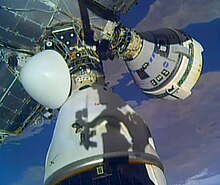
As of 25 March 2024[ref], 280 people representing 23 countries had visited the space station, many of them multiple times. The United States has sent 163 people, Russia has 58, Japan has sent 11, Canada has sent nine, Italy has sent six, France and Germany have each sent four, Saudi Arabia, Sweden and the United Arab Emirates have each sent two, and there has been one person from Belarus, Belgium, Brazil, Denmark, Israel, Kazakhstan, Malaysia, Netherlands, South Africa, South Korea, Spain, Turkey and the United Kingdom.[269]
Uncrewed
[edit]Uncrewed spaceflights are made primarily to deliver cargo, however several Russian modules have also docked to the outpost following uncrewed launches. Resupply missions typically use the Russian Progress spacecraft, former European ATVs, Japanese Kounotori vehicles, and the American Dragon and Cygnus spacecraft.
Currently docked/berthed
[edit]
All dates are UTC. Departure dates are the earliest possible (NET) and may change.
| Mission | Type | Spacecraft | Arrival | Departure | Port | |
|---|---|---|---|---|---|---|
| Progress MS-27 | Uncrewed | Progress MS No. 457 | 1 June 2024 | 19 November 2024 | Poisk zenith | |
| CRS NG-21 | Uncrewed | Cygnus S.S. Francis R. "Dick" Scobee | 6 August 2024 | January 2025 | Unity nadir | |
| Progress MS-28 | Uncrewed | Progress MS No. 458 | 17 August 2024 | 2025 | Zvezda aft | |
| Soyuz MS-26 | Crewed | Soyuz MS No. 757 Burlak | 11 September 2024 | March 2025 | Rassvet nadir | |
| Crew-9 | Crewed | Crew Dragon Freedom | 29 September 2024 | February 2025 | Harmony zenith | |
Scheduled missions
[edit]All dates are UTC. Launch dates are the earliest possible (NET) and may change.
| Mission | Type | Spacecraft | Launch date[270] | Launch vehicle | Launch site | Launch provider | Docking/berthing port | |
|---|---|---|---|---|---|---|---|---|
| CRS SpX-31 | Uncrewed | Cargo Dragon C208 | 5 November 2024 | Falcon 9 | Kennedy, LC‑39A | SpaceX | Harmony forward | |
| Progress MS-29 | Uncrewed | Progress MS No. 459 | 21 November 2024 | Soyuz 2.1a | Baikonur, Site 31/6 | Progress | Poisk zenith | |
| Crew-10 | Crewed | Crew Dragon C213 | February 2025 | Falcon 9 | TBD | SpaceX | Harmony forward, later zenith | |
| CRS NG-22 | Uncrewed | Cygnus | February 2025 | Falcon 9 | TBD | SpaceX | Unity nadir | |
| CRS SpX-32 | Uncrewed | Cargo Dragon TBD | March 2025 | Falcon 9 | TBD | SpaceX | Harmony forward | |
| Ax-4 | Crewed | Crew Dragon Freedom | April 2025 | Falcon 9 | TBD | SpaceX | Harmony forward | |
| SSC Demo-1 | Uncrewed | Dream Chaser Tenacity | May 2024 | Vulcan Centaur | Cape Canaveral, SLC-41 | ULA | Harmony or Unity nadir | |
| CRS NG-23 | Uncrewed | Cygnus | August 2025 | Antares 330 | Wallops, LP‑0A | Northrop Grumman | Unity nadir | |
| HTV-X1 | Uncrewed | HTV-X | September 2025 | H3-24L | Tanegashima, LA-Y2 | JAXA | Harmony or Unity nadir | |
Docking and berthing of spacecraft
[edit]
The Russian spacecraft and can autonomously rendezvous and dock with the station without human intervention. Once within approximately 200 kilometres (120 mi), the spacecraft begins receiving radio signals from the Kurs docking navigation system on the station. As the spacecraft nears the station, laser-based optical equipment precisely aligns the craft with the docking port and controls the final approach. While the crew on the ISS and spacecraft monitor the procedure, their role is primarily supervisory, with intervention limited to issuing abort commands in emergencies. Although initial development costs were substantial, the system's reliability and standardized components have yielded significant cost reductions for subsequent missions.[271]
The American SpaceX Dragon 2 cargo and crewed spacecraft can autonomously rendezvous and dock with the station without human intervention. However, on crewed Dragon missions, the astronauts have the capability to intervene and fly the vehicle manually.[272]
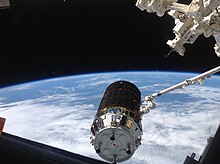
Other automated cargo spacecraft typically use a semi-automated process when arriving and departing from the station. These spacecraft are instructed to approach and park near the station. Once the crew on board the station is ready, the spacecraft is commanded to come close to the station, so that it can be grappled by an astronaut using the Mobile Servicing System robotic arm. The final mating of the spacecraft to the station is achieved using the robotic arm (a process known as berthing). Spacecraft using this semi-automated process include the American Cygnus and the Japanese HTV-X. The now-retired American SpaceX Dragon 1, European ATV and Japanese HTV also used this process.
Launch and docking windows
[edit]Prior to a spacecraft's docking to the ISS, navigation and attitude control (GNC) is handed over to the ground control of the spacecraft's country of origin. GNC is set to allow the station to drift in space, rather than fire its thrusters or turn using gyroscopes. The solar panels of the station are turned edge-on to the incoming spacecraft, so residue from its thrusters does not damage the cells. Before its retirement, Shuttle launches were often given priority over Soyuz, with occasional priority given to Soyuz arrivals carrying crew and time-critical cargoes, such as biological experiment materials.[273]
Repairs
[edit]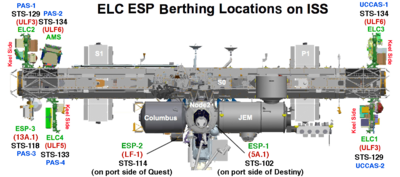
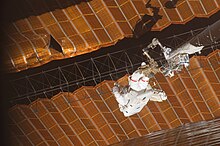

Orbital Replacement Units (ORUs) are spare parts that can be readily replaced when a unit either passes its design life or fails. Examples of ORUs are pumps, storage tanks, controller boxes, antennas, and battery units. Some units can be replaced using robotic arms. Most are stored outside the station, either on small pallets called ExPRESS Logistics Carriers (ELCs) or share larger platforms called External Stowage Platforms (ESPs) which also hold science experiments. Both kinds of pallets provide electricity for many parts that could be damaged by the cold of space and require heating. The larger logistics carriers also have local area network (LAN) connections for telemetry to connect experiments. A heavy emphasis on stocking the USOS with ORU's occurred around 2011, before the end of the NASA shuttle programme, as its commercial replacements, Cygnus and Dragon, carry one tenth to one quarter the payload.
Unexpected problems and failures have impacted the station's assembly time-line and work schedules leading to periods of reduced capabilities and, in some cases, could have forced abandonment of the station for safety reasons. Serious problems include an air leak from the USOS in 2004,[274] the venting of fumes from an Elektron oxygen generator in 2006,[275] and the failure of the computers in the ROS in 2007 during STS-117 that left the station without thruster, Elektron, Vozdukh and other environmental control system operations. In the latter case, the root cause was found to be condensation inside electrical connectors leading to a short circuit.[276]
During STS-120 in 2007 and following the relocation of the P6 truss and solar arrays, it was noted during unfurling that the solar array had torn and was not deploying properly.[277] An EVA was carried out by Scott Parazynski, assisted by Douglas Wheelock. Extra precautions were taken to reduce the risk of electric shock, as the repairs were carried out with the solar array exposed to sunlight.[278] The issues with the array were followed in the same year by problems with the starboard Solar Alpha Rotary Joint (SARJ), which rotates the arrays on the starboard side of the station. Excessive vibration and high-current spikes in the array drive motor were noted, resulting in a decision to substantially curtail motion of the starboard SARJ until the cause was understood. Inspections during EVAs on STS-120 and STS-123 showed extensive contamination from metallic shavings and debris in the large drive gear and confirmed damage to the large metallic bearing surfaces, so the joint was locked to prevent further damage.[279][280] Repairs to the joints were carried out during STS-126 with lubrication and the replacement of 11 out of 12 trundle bearings on the joint.[281][282]
In September 2008, damage to the S1 radiator was first noticed in Soyuz imagery. The problem was initially not thought to be serious.[283] The imagery showed that the surface of one sub-panel had peeled back from the underlying central structure, possibly because of micro-meteoroid or debris impact. On 15 May 2009, the damaged radiator panel's ammonia tubing was mechanically shut off from the rest of the cooling system by the computer-controlled closure of a valve. The same valve was then used to vent the ammonia from the damaged panel, eliminating the possibility of an ammonia leak.[283] It is also known that a Service Module thruster cover struck the S1 radiator after being jettisoned during an EVA in 2008, but its effect, if any, has not been determined.
In the early hours of 1 August 2010, a failure in cooling Loop A (starboard side), one of two external cooling loops, left the station with only half of its normal cooling capacity and zero redundancy in some systems.[284][285][286] The problem appeared to be in the ammonia pump module that circulates the ammonia cooling fluid. Several subsystems, including two of the four CMGs, were shut down.
Planned operations on the ISS were interrupted through a series of EVAs to address the cooling system issue. A first EVA on 7 August 2010, to replace the failed pump module, was not fully completed because of an ammonia leak in one of four quick-disconnects. A second EVA on 11 August removed the failed pump module.[287][288] A third EVA was required to restore Loop A to normal functionality.[289][290]
The USOS's cooling system is largely built by the US company Boeing,[291] which is also the manufacturer of the failed pump.[284]
The four Main Bus Switching Units (MBSUs, located in the S0 truss), control the routing of power from the four solar array wings to the rest of the ISS. Each MBSU has two power channels that feed 160V DC from the arrays to two DC-to-DC power converters (DDCUs) that supply the 124V power used in the station. In late 2011, MBSU-1 ceased responding to commands or sending data confirming its health. While still routing power correctly, it was scheduled to be swapped out at the next available EVA. A spare MBSU was already on board, but a 30 August 2012 EVA failed to be completed when a bolt being tightened to finish installation of the spare unit jammed before the electrical connection was secured.[292] The loss of MBSU-1 limited the station to 75% of its normal power capacity, requiring minor limitations in normal operations until the problem could be addressed.
On 5 September 2012, in a second six-hour EVA, astronauts Sunita Williams and Akihiko Hoshide successfully replaced MBSU-1 and restored the ISS to 100% power.[293]
On 24 December 2013, astronauts installed a new ammonia pump for the station's cooling system. The faulty cooling system had failed earlier in the month, halting many of the station's science experiments. Astronauts had to brave a "mini blizzard" of ammonia while installing the new pump. It was only the second Christmas Eve spacewalk in NASA history.[294]
Mission control centres
[edit]The components of the ISS are operated and monitored by their respective space agencies at mission control centres across the globe, primarly the Christopher C. Kraft Jr. Mission Control Center in Houston and the RKA Mission Control Center (TsUP) in Moscow, with support from Tsukuba Space Center in Japan, Payload Operations and Integration Center in Huntsville, Alabama, U.S., Columbus Control Center in Munich, Germany and Mobile Servicing System Control at the Canadian Space Agency’s headquarters in Saint-Hubert, Quebec.
Life aboard
[edit]Living quarters
[edit]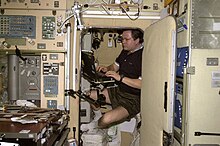
The living and working space on the International Space Station is larger than a six-bedroom house (complete with seven sleeping quarters, two bathrooms, a gym, and a 360-degree view bay window).[295]
Crew activities
[edit]
A typical day for the crew begins with a wake-up at 06:00, followed by post-sleep activities and a morning inspection of the station. The crew then eats breakfast and takes part in a daily planning conference with Mission Control before starting work at around 08:10. The first scheduled exercise of the day follows, after which the crew continues work until 13:05. Following a one-hour lunch break, the afternoon consists of more exercise and work before the crew carries out its pre-sleep activities beginning at 19:30, including dinner and a crew conference. The scheduled sleep period begins at 21:30. In general, the crew works ten hours per day on a weekday, and five hours on Saturdays, with the rest of the time their own for relaxation or work catch-up.[296]
The time zone used aboard the ISS is Coordinated Universal Time (UTC).[297] The windows are covered during night hours to give the impression of darkness because the station experiences 16 sunrises and sunsets per day. During visiting Space Shuttle missions, the ISS crew mostly follow the shuttle's Mission Elapsed Time (MET), which is a flexible time zone based on the launch time of the Space Shuttle mission.[298][299][300]
The station provides crew quarters for each member of the expedition's crew, with two "sleep stations" in the Zvezda, one in Nauka and four more installed in Harmony.[301][302][303][304] The USOS quarters are private, approximately person-sized soundproof booths. The ROS crew quarters in Zvezda include a small window, but provide less ventilation and sound proofing. A crew member can sleep in a crew quarter in a tethered sleeping bag, listen to music, use a laptop, and store personal items in a large drawer or in nets attached to the module's walls. The module also provides a reading lamp, a shelf and a desktop.[305][306][307] Visiting crews have no allocated sleep module, and attach a sleeping bag to an available space on a wall. It is possible to sleep floating freely through the station, but this is generally avoided because of the possibility of bumping into sensitive equipment.[308] It is important that crew accommodations be well ventilated; otherwise, astronauts can wake up oxygen-deprived and gasping for air, because a bubble of their own exhaled carbon dioxide has formed around their heads.[305] During various station activities and crew rest times, the lights in the ISS can be dimmed, switched off, and colour temperatures adjusted.[309][310]
Reflection and material culture
[edit]Reflection of individual and crew characteristics are found particularly in the decoration of the station and expressions in general, such as religion.[311] The latter has produced a certain material economy between the station and Russia in particular.[312]
The micro-society of the station, as well as wider society, and possibly the emergence of distinct station cultures,[313] is being studied by analyzing many aspects, from art to dust accumulation, as well as archaeologically how material of the ISS has been discarded.[314]
Food and personal hygiene
[edit]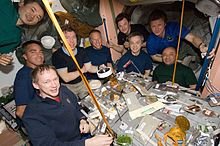
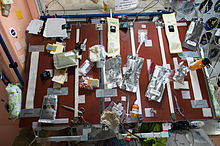
On the USOS, most of the food aboard is vacuum sealed in plastic bags; cans are rare because they are heavy and expensive to transport. Preserved food is not highly regarded by the crew and taste is reduced in microgravity,[305] so efforts are taken to make the food more palatable, including using more spices than in regular cooking. The crew looks forward to the arrival of any spacecraft from Earth as they bring fresh fruit and vegetables. Care is taken that foods do not create crumbs, and liquid condiments are preferred over solid to avoid contaminating station equipment. Each crew member has individual food packages and cooks them in the galley, which has two food warmers, a refrigerator (added in November 2008), and a water dispenser that provides heated and unheated water.[306] Drinks are provided as dehydrated powder that is mixed with water before consumption.[306][307] Drinks and soups are sipped from plastic bags with straws, while solid food is eaten with a knife and fork attached to a tray with magnets to prevent them from floating away. Any food that floats away, including crumbs, must be collected to prevent it from clogging the station's air filters and other equipment.[307]
Showers on space stations were introduced in the early 1970s on Skylab and Salyut 3.[315]: 139 By Salyut 6, in the early 1980s, the crew complained of the complexity of showering in space, which was a monthly activity.[316] The ISS does not feature a shower; instead, crewmembers wash using a water jet and wet wipes, with soap dispensed from a toothpaste tube-like container. Crews are also provided with rinseless shampoo and edible toothpaste to save water.[308][317]
There are two space toilets on the ISS, both of Russian design, located in Zvezda and Tranquility.[306] These Waste and Hygiene Compartments use a fan-driven suction system similar to the Space Shuttle Waste Collection System. Astronauts first fasten themselves to the toilet seat, which is equipped with spring-loaded restraining bars to ensure a good seal.[305] A lever operates a powerful fan and a suction hole slides open: the air stream carries the waste away. Solid waste is collected in individual bags which are stored in an aluminium container. Full containers are transferred to Progress spacecraft for disposal.[306][318] Liquid waste is evacuated by a hose connected to the front of the toilet, with anatomically correct "urine funnel adapters" attached to the tube so that men and women can use the same toilet. The diverted urine is collected and transferred to the Water Recovery System, where it is recycled into drinking water.[307] In 2021, the arrival of the Nauka module also brought a third toilet to the ISS.[319]
Crew health and safety
[edit]Overall
[edit]On 12 April 2019, NASA reported medical results from the Astronaut Twin Study. Astronaut Scott Kelly spent a year in space on the ISS, while his twin spent the year on Earth. Several long-lasting changes were observed, including those related to alterations in DNA and cognition, when one twin was compared with the other.[320][321]
In November 2019, researchers reported that astronauts experienced serious blood flow and clot problems while on board the ISS, based on a six-month study of 11 healthy astronauts. The results may influence long-term spaceflight, including a mission to the planet Mars, according to the researchers.[322][323]
Radiation
[edit]The ISS is partially protected from the space environment by Earth's magnetic field. From an average distance of about 70,000 km (43,000 mi) from the Earth's surface, depending on Solar activity, the magnetosphere begins to deflect solar wind around Earth and the space station. Solar flares are still a hazard to the crew, who may receive only a few minutes warning. In 2005, during the initial "proton storm" of an X-3 class solar flare, the crew of Expedition 10 took shelter in a more heavily shielded part of the ROS designed for this purpose.[324][325]
Subatomic charged particles, primarily protons from cosmic rays and solar wind, are normally absorbed by Earth's atmosphere. When they interact in sufficient quantity, their effect is visible to the naked eye in a phenomenon called an aurora. Outside Earth's atmosphere, ISS crews are exposed to approximately one millisievert each day (about a year's worth of natural exposure on Earth), resulting in a higher risk of cancer. Radiation can penetrate living tissue and damage the DNA and chromosomes of lymphocytes; being central to the immune system, any damage to these cells could contribute to the lower immunity experienced by astronauts. Radiation has also been linked to a higher incidence of cataracts in astronauts. Protective shielding and medications may lower the risks to an acceptable level.[45]
Radiation levels on the ISS are between 12 and 28.8 milli rads per day,[326] about five times greater than those experienced by airline passengers and crew, as Earth's electromagnetic field provides almost the same level of protection against solar and other types of radiation in low Earth orbit as in the stratosphere. For example, on a 12-hour flight, an airline passenger would experience 0.1 millisieverts of radiation, or a rate of 0.2 millisieverts per day; this is one fifth the rate experienced by an astronaut in LEO. Additionally, airline passengers experience this level of radiation for a few hours of flight, while the ISS crew are exposed for their whole stay on board the station.[327]
Stress
[edit]There is considerable evidence that psychosocial stressors are among the most important impediments to optimal crew morale and performance.[328] Cosmonaut Valery Ryumin wrote in his journal during a particularly difficult period on board the Salyut 6 space station: "All the conditions necessary for murder are met if you shut two men in a cabin measuring 18 feet by 20 [5.5 m × 6 m] and leave them together for two months."
NASA's interest in psychological stress caused by space travel, initially studied when their crewed missions began, was rekindled when astronauts joined cosmonauts on the Russian space station Mir. Common sources of stress in early US missions included maintaining high performance under public scrutiny and isolation from peers and family. The latter is still often a cause of stress on the ISS, such as when the mother of NASA astronaut Daniel Tani died in a car accident, and when Michael Fincke was forced to miss the birth of his second child.
A study of the longest spaceflight concluded that the first three weeks are a critical period where attention is adversely affected because of the demand to adjust to the extreme change of environment.[329] ISS crew flights typically last about five to six months.
The ISS working environment includes further stress caused by living and working in cramped conditions with people from very different cultures who speak a different language. First-generation space stations had crews who spoke a single language; second- and third-generation stations have crew from many cultures who speak many languages. Astronauts must speak English and Russian, and knowing additional languages is even better.[330]
Due to the lack of gravity, confusion often occurs. Even though there is no up and down in space, some crew members feel like they are oriented upside down. They may also have difficulty measuring distances. This can cause problems like getting lost inside the space station, pulling switches in the wrong direction or misjudging the speed of an approaching vehicle during docking.[331]
Medical
[edit]
The physiological effects of long-term weightlessness include muscle atrophy, deterioration of the skeleton (osteopenia), fluid redistribution, a slowing of the cardiovascular system, decreased production of red blood cells, balance disorders, and a weakening of the immune system. Lesser symptoms include loss of body mass, and puffiness of the face.[45]
Sleep is regularly disturbed on the ISS because of mission demands, such as incoming or departing spacecraft. Sound levels in the station are unavoidably high. The atmosphere is unable to thermosiphon naturally, so fans are required at all times to process the air which would stagnate in the freefall (zero-G) environment.
To prevent some of the adverse effects on the body, the station is equipped with: two TVIS treadmills (including the COLBERT); the ARED (Advanced Resistive Exercise Device), which enables various weightlifting exercises that add muscle without raising (or compensating for) the astronauts' reduced bone density;[332] and a stationary bicycle. Each astronaut spends at least two hours per day exercising on the equipment.[305][306] Astronauts use bungee cords to strap themselves to the treadmill.[333][334]
Microbiological environmental hazards
[edit]Hazardous molds that can foul air and water filters may develop aboard space stations. They can produce acids that degrade metal, glass, and rubber. They can also be harmful to the crew's health. Microbiological hazards have led to a development of the LOCAD-PTS (a portable test system) which identifies common bacteria and molds faster than standard methods of culturing, which may require a sample to be sent back to Earth.[335] Researchers in 2018 reported, after detecting the presence of five Enterobacter bugandensis bacterial strains on the ISS (none of which are pathogenic to humans), that microorganisms on the ISS should be carefully monitored to continue assuring a medically healthy environment for astronauts.[336][337]
Contamination on space stations can be prevented by reduced humidity, and by using paint that contains mold-killing chemicals, as well as the use of antiseptic solutions. All materials used in the ISS are tested for resistance against fungi.[338] Since 2016, a series of ESA-sponsored experiments have been conducted to test the anti-bacterial properties of various materials, with the goal of developing "smart surfaces" that mitigate bacterial growth in multiple ways, using the best method for a particular circumstance. Dubbed "Microbial Aerosol Tethering on Innovative Surfaces" (MATISS), the programme involves deployment of small plaques containing an array of glass squares covered with different test coatings. They remain on the station for six months before being returned to earth for analysis.[339] The most recent and final experiment of the series was launched on 5 June 2023 aboard the SpaceX CRS-28 cargo mission to ISS, comprising four plaques. Whereas previous experiments in the series were limited to analysis by light microsocopy, this experiment uses quartz glass made of pure silica, which will allow spectrographic analysis. Two of the plaques were returned after eight months and the remaining two after 16 months.[340]
In April 2019, NASA reported that a comprehensive study had been conducted into the microorganisms and fungi present on the ISS. The experiment was performed over a period of 14 months on three different flight missions, and involved taking samples from 8 predefined locations inside the station, then returning them to earth for analysis. In prior experiments, analysis was limited to culture-based methods, thus overlooking microbes which cannot be grown in culture. The present study used molecular-based methods in addition to culturing, resulting in a more complete catalog. The results may be useful in improving the health and safety conditions for astronauts, as well as better understanding other closed-in environments on Earth such as clean rooms used by the pharmaceutical and medical industries.[341][342]
Noise
[edit]Space flight is not inherently quiet, with noise levels exceeding acoustic standards as far back as the Apollo missions.[343][344] For this reason, NASA and the International Space Station international partners have developed noise control and hearing loss prevention goals as part of the health program for crew members. Specifically, these goals have been the primary focus of the ISS Multilateral Medical Operations Panel (MMOP) Acoustics Subgroup since the first days of ISS assembly and operations.[345][346] The effort includes contributions from acoustical engineers, audiologists, industrial hygienists, and physicians who comprise the subgroup's membership from NASA, Roscosmos, the European Space Agency (ESA), the Japanese Aerospace Exploration Agency (JAXA), and the Canadian Space Agency (CSA).
When compared to terrestrial environments, the noise levels incurred by astronauts and cosmonauts on the ISS may seem insignificant and typically occur at levels that would not be of major concern to the Occupational Safety and Health Administration – rarely reaching 85 dBA. But crew members are exposed to these levels 24 hours a day, seven days a week, with current missions averaging six months in duration. These levels of noise also impose risks to crew health and performance in the form of sleep interference and communication, as well as reduced alarm audibility.
Over the 19 plus year history of the ISS, significant efforts have been put forth to limit and reduce noise levels on the ISS. During design and pre-flight activities, members of the Acoustic Subgroup have written acoustic limits and verification requirements, consulted to design and choose the quietest available payloads, and then conducted acoustic verification tests prior to launch.[345]: 5.7.3 During spaceflights, the Acoustics Subgroup has assessed each ISS module's in flight sound levels, produced by a large number of vehicle and science experiment noise sources, to assure compliance with strict acoustic standards. The acoustic environment on ISS changed when additional modules were added during its construction, and as additional spacecraft arrive at the ISS. The Acoustics Subgroup has responded to this dynamic operations schedule by successfully designing and employing acoustic covers, absorptive materials, noise barriers, and vibration isolators to reduce noise levels. Moreover, when pumps, fans, and ventilation systems age and show increased noise levels, this Acoustics Subgroup has guided ISS managers to replace the older, noisier instruments with quiet fan and pump technologies, significantly reducing ambient noise levels.
NASA has adopted most-conservative damage risk criteria (based on recommendations from the National Institute for Occupational Safety and Health and the World Health Organization), in order to protect all crew members. The MMOP Acoustics Subgroup has adjusted its approach to managing noise risks in this unique environment by applying, or modifying, terrestrial approaches for hearing loss prevention to set these conservative limits. One innovative approach has been NASA's Noise Exposure Estimation Tool (NEET), in which noise exposures are calculated in a task-based approach to determine the need for hearing protection devices (HPDs). Guidance for use of HPDs, either mandatory use or recommended, is then documented in the Noise Hazard Inventory, and posted for crew reference during their missions. The Acoustics Subgroup also tracks spacecraft noise exceedances, applies engineering controls, and recommends hearing protective devices to reduce crew noise exposures. Finally, hearing thresholds are monitored on-orbit, during missions.
There have been no persistent mission-related hearing threshold shifts among US Orbital Segment crewmembers (JAXA, CSA, ESA, NASA) during what is approaching 20 years of ISS mission operations, or nearly 175,000 work hours. In 2020, the MMOP Acoustics Subgroup received the Safe-In-Sound Award for Innovation for their combined efforts to mitigate any health effects of noise.[347]
Fire and toxic gases
[edit]An onboard fire or a toxic gas leak are other potential hazards. Ammonia is used in the external radiators of the station and could potentially leak into the pressurised modules.[348]
Orbit, environment, debris and visibility
[edit]
Altitude and orbital inclination
[edit]The ISS is currently maintained in a nearly circular orbit with a minimum mean altitude of 370 km (230 mi) and a maximum of 460 km (290 mi),[349] in the centre of the thermosphere, at an inclination of 51.6 degrees to Earth's equator with an eccentricity of 0.007.[citation needed] This orbit was selected because it is the lowest inclination that can be directly reached by Russian Soyuz and Progress spacecraft launched from Baikonur Cosmodrome at 46° N latitude without overflying China or dropping spent rocket stages in inhabited areas.[350][351] It travels at an average speed of 28,000 kilometres per hour (17,000 mph), and completes 15.5 orbits per day (93 minutes per orbit).[3][352] The station's altitude was allowed to fall around the time of each NASA shuttle flight to permit heavier loads to be transferred to the station. After the retirement of the shuttle, the nominal orbit of the space station was raised in altitude (from about 350 km to about 400 km).[353][354] Other, more frequent supply spacecraft do not require this adjustment as they are substantially higher performance vehicles.[28][355]
Atmospheric drag reduces the altitude by about 2 km a month on average. Orbital boosting can be performed by the station's two main engines on the Zvezda service module, or Russian or European spacecraft docked to Zvezda's aft port. The Automated Transfer Vehicle is constructed with the possibility of adding a second docking port to its aft end, allowing other craft to dock and boost the station. It takes approximately two orbits (three hours) for the boost to a higher altitude to be completed.[355] Maintaining ISS altitude uses about 7.5 tonnes of chemical fuel per annum[356] at an annual cost of about $210 million.[357]
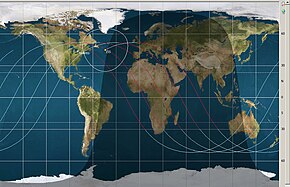
The Russian Orbital Segment contains the Data Management System, which handles Guidance, Navigation and Control (ROS GNC) for the entire station.[358] Initially, Zarya, the first module of the station, controlled the station until a short time after the Russian service module Zvezda docked and was transferred control. Zvezda contains the ESA built DMS-R Data Management System.[359] Using two fault-tolerant computers (FTC), Zvezda computes the station's position and orbital trajectory using redundant Earth horizon sensors, Solar horizon sensors as well as Sun and star trackers. The FTCs each contain three identical processing units working in parallel and provide advanced fault-masking by majority voting.
Orientation
[edit]Zvezda uses gyroscopes (reaction wheels) and thrusters to turn itself. Gyroscopes do not require propellant; instead they use electricity to 'store' momentum in flywheels by turning in the opposite direction to the station's movement. The USOS has its own computer-controlled gyroscopes to handle its extra mass. When gyroscopes 'saturate', thrusters are used to cancel out the stored momentum. In February 2005, during Expedition 10, an incorrect command was sent to the station's computer, using about 14 kilograms of propellant before the fault was noticed and fixed. When attitude control computers in the ROS and USOS fail to communicate properly, this can result in a rare 'force fight' where the ROS GNC computer must ignore the USOS counterpart, which itself has no thrusters.[360][361][362]
Docked spacecraft can also be used to maintain station attitude, such as for troubleshooting or during the installation of the S3/S4 truss, which provides electrical power and data interfaces for the station's electronics.[363]
Orbital debris threats
[edit]The low altitudes at which the ISS orbits are also home to a variety of space debris,[364] including spent rocket stages, defunct satellites, explosion fragments (including materials from anti-satellite weapon tests), paint flakes, slag from solid rocket motors, and coolant released by US-A nuclear-powered satellites. These objects, in addition to natural micrometeoroids,[365] are a significant threat. Objects large enough to destroy the station can be tracked, and therefore are not as dangerous as smaller debris.[366][367] Objects too small to be detected by optical and radar instruments, from approximately 1 cm down to microscopic size, number in the trillions. Despite their small size, some of these objects are a threat because of their kinetic energy and direction in relation to the station. Spacewalking crew in spacesuits are also at risk of suit damage and consequent exposure to vacuum.[368]
Ballistic panels, also called micrometeorite shielding, are incorporated into the station to protect pressurised sections and critical systems. The type and thickness of these panels depend on their predicted exposure to damage. The station's shields and structure have different designs on the ROS and the USOS. On the USOS, Whipple Shields are used. The US segment modules consist of an inner layer made from 1.5–5.0 cm-thick (0.59–1.97 in) aluminium, a 10 cm-thick (3.9 in) intermediate layers of Kevlar and Nextel (a ceramic fabric),[369] and an outer layer of stainless steel, which causes objects to shatter into a cloud before hitting the hull, thereby spreading the energy of impact. On the ROS, a carbon fibre reinforced polymer honeycomb screen is spaced from the hull, an aluminium honeycomb screen is spaced from that, with a screen-vacuum thermal insulation covering, and glass cloth over the top.[370]
Space debris is tracked remotely from the ground, and the station crew can be notified.[371] If necessary, thrusters on the Russian Orbital Segment can alter the station's orbital altitude, avoiding the debris. These Debris Avoidance Manoeuvres (DAMs) are not uncommon, taking place if computational models show the debris will approach within a certain threat distance. Ten DAMs had been performed by the end of 2009.[372][373][374] Usually, an increase in orbital velocity of the order of 1 m/s is used to raise the orbit by one or two kilometres. If necessary, the altitude can also be lowered, although such a manoeuvre wastes propellant.[373][375] If a threat from orbital debris is identified too late for a DAM to be safely conducted, the station crew close all the hatches aboard the station and retreat into their spacecraft in order to be able to evacuate in the event the station was seriously damaged by the debris. Partial station evacuations have occurred on 13 March 2009, 28 June 2011, 24 March 2012, 16 June 2015,[376] November 2021,[377] and 27 June 2024.[378]
The November 2021 evacuation was caused by a Russian anti-satellite weapon test.[379][380] NASA administrator Bill Nelson said it was unthinkable that Russia would endanger the lives of everyone on ISS, including their own cosmonauts.[381]
- A 7-gram object (shown in centre) shot at 7 km/s (23,000 ft/s), the orbital velocity of the ISS, made this 15 cm (5.9 in) crater in a solid block of aluminium.
- Radar-trackable objects, including debris, with distinct ring of geostationary satellites
- Example of risk management: A NASA model showing areas at high risk from impact for the International Space Station
Visibility from Earth
[edit]The ISS is visible in the sky to the naked eye as a visibly moving, bright white dot, when crossing the sky and being illuminated by the Sun, during twilight, the hours after sunset and before sunrise, when the station remains sunlit, outside of Earth's shadow, but the ground and sky are dark.[382] It crosses the skies at latitudes between the polar regions.[383] Depending on the path it takes across the sky, the time it takes the station to move across the horizon or from one to the other may be short or up to 10 minutes, while likely being only visible part of that time because of it moving into or out of Earth's shadow. It then returns around every 90 minutes, with the time of the day that it crosses the sky shifting over the course of some weeks, and therefore before returning to twilight and visible illumination.
Because of the size of its reflective surface area, the ISS is the brightest artificial object in the sky (excluding other satellite flares), with an approximate maximum magnitude of −4 when in sunlight and overhead (similar to Venus), and a maximum angular size of 63 arcseconds.[384]
Tools are provided by a number of websites such as Heavens-Above (see Live viewing below) as well as smartphone applications that use orbital data and the observer's longitude and latitude to indicate when the ISS will be visible (weather permitting), where the station will appear to rise, the altitude above the horizon it will reach and the duration of the pass before the station disappears either by setting below the horizon or entering into Earth's shadow.[385][386][387][388]
In November 2012 NASA launched its "Spot the Station" service, which sends people text and email alerts when the station is due to fly above their town.[389] The station is visible from 95% of the inhabited land on Earth, but is not visible from extreme northern or southern latitudes.[350]
Under specific conditions, the ISS can be observed at night on five consecutive orbits. Those conditions are 1) a mid-latitude observer location, 2) near the time of the solstice with 3) the ISS passing in the direction of the pole from the observer near midnight local time. The three photos show the first, middle and last of the five passes on 5–6 June 2014.
- Skytrack long duration exposure of the ISS
- The ISS on its first pass of the night passing nearly overhead shortly after sunset in June 2014
- The ISS passing north on its third pass of the night near local midnight in June 2014
- The ISS passing west on its fifth pass of the night before sunrise in June 2014
Astrophotography
[edit]
Using a telescope-mounted camera to photograph the station is a popular hobby for astronomers,[390] while using a mounted camera to photograph the Earth and stars is a popular hobby for crew.[391] The use of a telescope or binoculars allows viewing of the ISS during daylight hours.[392]
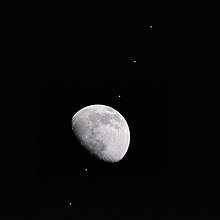
Transits of the ISS in front of the Sun, particularly during an eclipse (and so the Earth, Sun, Moon, and ISS are all positioned approximately in a single line) are of particular interest for amateur astronomers.[393][394]
International co-operation
[edit]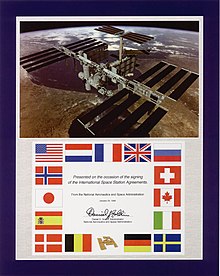
Involving five space programs and fifteen countries,[395] the International Space Station is the most politically and legally complex space exploration programme in history.[395] The 1998 Space Station Intergovernmental Agreement sets forth the primary framework for international cooperation among the parties. A series of subsequent agreements govern other aspects of the station, ranging from jurisdictional issues to a code of conduct among visiting astronauts.[396]
Brazil was also invited to participate in the programme, the only developing country to receive such an invitation. Under the agreement framework, Brazil was to provide six pieces of hardware, and in exchange, would receive ISS utilization rights. However, Brazil was unable to deliver any of the elements due to a lack of funding and political priority within the country. Brazil officially dropped out of the ISS programme in 2007.[397][398]
Following the 2022 Russian invasion of Ukraine, continued cooperation between Russia and other countries on the International Space Station has been put into question. Roscosmos Director General Dmitry Rogozin insinuated that Russian withdrawal could cause the International Space Station to de-orbit due to lack of reboost capabilities, writing in a series of tweets, "If you block cooperation with us, who will save the ISS from an unguided de-orbit to impact on the territory of the US or Europe? There's also the chance of impact of the 500-ton construction in India or China. Do you want to threaten them with such a prospect? The ISS doesn't fly over Russia, so all the risk is yours. Are you ready for it?"[399] (This latter claim is untrue: the ISS flies over all parts of the Earth between 51.6 degrees latitude north and south, approximately the latitude of Saratov.) Rogozin later tweeted that normal relations between ISS partners could only be restored once sanctions have been lifted, and indicated that Roscosmos would submit proposals to the Russian government on ending cooperation.[400] NASA stated that, if necessary, US corporation Northrop Grumman has offered a reboost capability that would keep the ISS in orbit.[401]
On 26 July 2022, Yury Borisov, Rogozin's successor as head of Roscosmos, submitted to Russian President Putin plans for withdrawal from the programme after 2024.[402] However, Robyn Gatens, the NASA official in charge of the space station, responded that NASA had not received any formal notices from Roscosmos concerning withdrawal plans.[403]


 French
French Deutsch
Deutsch




